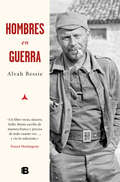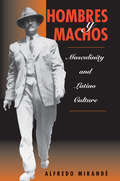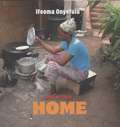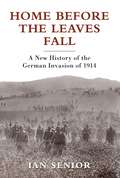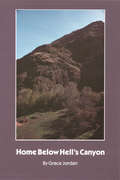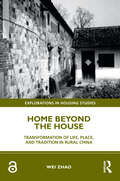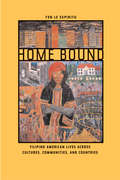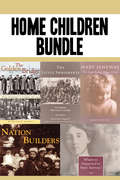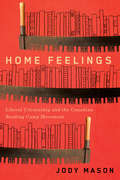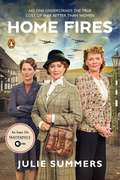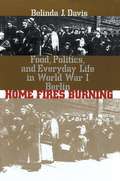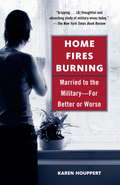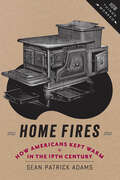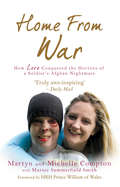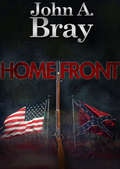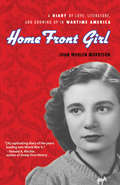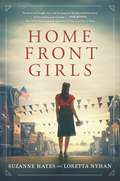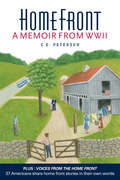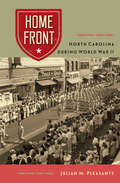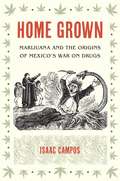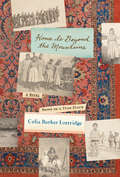- Table View
- List View
Hombres en guerra
by Alvah BessieLa obra maestra olvidada sobre la guerra civil española que fascinó a Ernest Hemingway. Hombres en guerra es un clásico que habla de soldados en la línea de fuego, y uno de los mejores testimonios jamás escritos sobre cualquier guerra. Su autor, Alvah Bessie, fue un escritor y periodista estadounidense que en 1938 combatió en la guerra civil española como voluntario de la Brigada Lincoln. Al volver a su país convirtió los cuadernos que había escrito durante la contienda en la base de este libro, que fue publicado en inglés en 1939 -gracias al apoyo de Ernest Hemingway-, coincidiendo con la invasión de Polonia por parte de la Alemania nazi. Pronto Bessie se convirtió en un reconocido guionista de la Warner Brothers. Sin embargo, en 1950, tras ser acusado por el macartismo de pertenecer al Partido Comunista, fue uno de los Diez de Hollywood, el grupo de personas obligadas a abandonar la industria cinematográfica. Estamos, pues, ante una obra de no ficción que posee un alto valor histórico y literario. En ella Alvah Bessie narra su llegada a España, su incorporación a la Brigada Lincoln, su adiestramiento y su participación en la batalla del Ebro; comparte con nosotros sus marchas nocturnas hasta la primera línea de fuego y los momentos de intimidad... Y al hacerlo nos ofrece un testimonio, entrañable y profundamente humano, de aquellos hombres y mujeres que vinieron de todos los rincones del mundo para luchar por una misma causa.
Hombres y Machos: Masculinity and Latino Culture
by Alfredo MirandeAlthough patriarchy, machismo, and excessive masculine displays are assumed to be prevalent among Latinos in general and Mexicans in particular, little is known about Latino men or macho masculinity. Hombres y Machos: Masculinity and Latino Culture fills an important void by providing an integrated view of Latino men, masculinity, and fatherhood?in the process refuting many common myths and misconceptions. <p>Examining how Latino men view themselves, Alfredo Mirande argues that prevailing conceptions of men, masculinity, and gender are inadequate because they are based not on universal norms but on limited and culturally specific conceptions. Findings are presented from in-depth personal interviews with Latino men (specifically, fathers with at least one child between the ages of four and eighteen living at home) from four geographical regions and from a broad cross-section of the Latino population: working and middle class, foreign-born and native-born. Topics range from views on machos and machismo to beliefs regarding masculinity and fatherhood. In addition to reporting research findings and placing them within a historical context, Mirande draws important insights from his own life. <p>Hombres y Machos calls for the development of Chicano/Latino men's studies and will be a significant and provocative addition to the growing literature on gender, masculinity, and race. It will appeal to the general reader and is bound to be an important supplementary text for courses in ethnic studies, women's studies, men's studies, family studies, sociology, psychology, social work, and law.
Home (Look at This!)
by Ifeoma OnyefuluCooking pot, stool, basket, water pot and sleeping mat... a first words book. Cooking pot, stool, basket, water pot and sleeping mat. . . All kinds of things around the home, with a vibrant mix of Western and traditional African objects. Photographed in Mali by an award-winning photographer, this is a unique and culturally diverse First Words book, with lots to look at and talk about. Also available in the "Look at This!" series: "Food," "Clothes," and "Play." Other books by this author are available in this library.
Home Before Morning: The Story of an Army Nurse in Vietnam
by Lynda Van Devanter Christopher MorganLynda Van Devanter was the girl next door, the cheerleader who went to Catholic schools, enjoyed sports, and got along well with her four sisters and parents. After high school she attended nursing school and then did something that would shatter her secure world for the rest of her life: in 1969, she joined the army and was shipped to Vietnam. When she arrived in Vietnam her idealistic view of the war vanished quickly. She worked long and arduous hours in cramped, ill-equipped, understaffed operating rooms. She saw friends die. Witnessing a war close-up, operating on soldiers and civilians whose injuries were catastrophic, she found the very foundations of her thinking changing daily. <P><P> After one traumatic year, she came home, a Vietnam veteran. Coming home was nearly as devastating as the time she spent in Asia. Nothing was the same ― including Lynda herself. Viewed by many as a murderer instead of a healer, she felt isolated and angry. The anger turned to depression; like many other Vietnam veterans she suffered from delayed stress syndrome. Working in hospitals brought back chilling scenes of hopelessly wounded soldiers. A marriage ended in divorce. The war that was fought physically halfway around the world had become a personal, internal battle.<P> Home before Morning is the story of a woman whose courage, stamina, and personal history make this a compelling autobiography. It is also the saga of others who went to war to aid the wounded and came back wounded ― physically and emotionally ― themselves. And, it is the true story of one person's triumphs: her understanding of, and coming to terms with, her destiny.
Home Before the Leaves Fall
by Ian SeniorThe German invasion of France and Belgium in August 1914 came within an ace of defeating the French armies, capturing Paris, and ending the First World War before the autumn leaves had fallen. But the German armies failed to score the knock-out blow they had planned. The war would drag on for four years of unprecedented slaughter. There are many accounts of 1914 from the British point of view. The achievements of the British Expeditionary Force were the stuff of legend, but in reality there were only four divisions in the field; the French and Germans had more than 60 each. The real story of the battle can only be told by an author with the skill to mine the extensive German and French archives. Ian Senior does this with consummate skill, weaving together strategic analysis with diary entries and interview transcripts from the soldiers on the ground to create a remarkable new history. In addition, all previous classic histories on the subject either focus virtually exclusively on the British experiences or are now very out-of-date such as Barbara Tuchman's Guns of August (1962) or Sewell Tyng's Campaign of the Marne (1935).Supported by up numerous sketch maps, extensive archival research and poignant first-hand accounts, Home before the leaves fall is an accessible, narrative account of the German invasion that came within an ace of victory, that long hot summer.
Home Below Hell's Canyon
by Grace JordanDuring the depression days of the early 1930s the Jordan family—Len Jordan (later governor of Idaho and a United States senator), his wife Grace, and their three small children—moved to an Idaho sheep ranch in the Snake River gorge just below Hell's Canyon, the deepest scratch on the face of North America. "Cut off from the world for months at a time, the Jordans became virtually self-sufficient. Short of cash but long on courage, they raised and preserved their food, made their own soap, and educated their children."—Sterling North, New York World-Telegram"Home Below Hell's Canyon is valuable because it writes a little-known way of life into the national chronicle. We are put in touch with the kind of people who set the country on its feet and in the generations since have kept it there. . . . Primarily it is a book of courage and effort tempered by the warmth of those who trust in goodness and practice it."—Christian Science Monitor“The thrilling story of a modern pioneer family. . . . An intensely human account filled with fun, courage and rich family life.”—Seattle Post Intelligencer
Home Beyond the House: Transformation of Life, Place, and Tradition in Rural China (Explorations in Housing Studies)
by Wei ZhaoBased on extended fieldwork conducted between 2007 and 2019, this book aims to answer a simple question: What is the meaning of home for people living in vernacular settlements in rural China? This question is particularly potent since rural China has experienced rapid and fundamental changes in the twenty-first century under the influences of national policies such as "Building a New Socialist Countryside" enacted in 2006 and "Rural Revitalization" announced in 2018. Drawing upon ethnographic fieldwork, building surveys, archival research, and over 600 photographs taken by residents along with their life stories, this book uncovers the meanings of home from rural residents’ perspectives, who belong to a social group that is underrepresented in scholarship and underserved in modern China. In other words, this study empowers rural residents by giving them voice. This book links the concepts of place, home, and tradition into an overarching argument: The meaning of home rests on the ideas of tradition, including identity, consanguinity, collectivity, social relations, land ownership, and rural lifestyle.
Home Bound: Filipino American Lives Across Cultures, Communities, and Countries
by Yen Le EspirituFilipino Americans, who experience life in the United States as immigrants, colonized nationals, and racial minorities, have been little studied, though they are one of our largest immigrant groups. Based on her in-depth interviews with more than one hundred Filipinos in San Diego, California, Yen Le Espiritu investigates how Filipino women and men are transformed through the experience of migration, and how they in turn remake the social world around them. Her sensitive analysis reveals that Filipino Americans confront U.S. domestic racism and global power structures by living transnational lives that are shaped as much by literal and symbolic ties to the Philippines as they are by social, economic, and political realities in the United States. Espiritu deftly weaves vivid first-person narratives with larger social and historical contexts as she discovers the meaning of home, community, gender, and intergenerational relations among Filipinos. Among other topics, she explores the ways that female sexuality is defined in contradistinction to American mores and shows how this process becomes a way of opposing racial subjugation in this country. She also examines how Filipinos have integrated themselves into the American workplace and looks closely at the effects of colonialism.
Home Children Bundle: The Golden Bridge / The Little Immigrants / Mary Janeway / Nation Builders / Whatever Happened to Mary Janeway?
by Mary Pettit Gail H. Corbett Marjorie Kohli Kenneth BagnellIn the early years after Confederation in Canada, the rising nation needed workers that could take advantage of the abundant resources. Until the time of the Depression, 100,000 impoverished children from the British Isles were sent overseas by well-meaning philanthropists to solve the colony’s farm-labour shortage. They were known as the "home children," and they were lonely and frightened youngsters to whom a new life in Canada meant only hardship and abuse. This bundle of titles tells the entire story from many angles and in its many facets, from historical recounting, to genealogical information, to the personal story one such child, Mary Janeway. Includes: The Golden Bridge The Little Immigrants Mary Janeway Nation Builders Whatever Happened to Mary Janeway?
Home Design With Feng Shui A-Z
by Terah Kathryn CollinsThe quick reference guide that makes Feng Shui easily accessible to everyone! Feng Shui expert Terah Kathryn Collins brings you clear, concise information on how to apply Feng Shui to every room of your home–from your bedroom to your home office.
Home Feelings: Liberal Citizenship and the Canadian Reading Camp Movement (Carleton Library Series #249)
by Jody MasonLiterature, literacy, and citizenship took on new and contested meanings in early twentieth-century Canada, particularly in frontier work camps. In this critical history of the reading camp movement, Jody Mason undertakes the first sustained analysis of the organization that became Frontier College in 1919. Employing an interdisciplinary approach, Home Feelings investigates how the reading camp movement used fiction, poetry, songs, newspapers, magazines, school readers, and English-as-a-second-language and citizenship manuals to encourage ideas of selfhood that were individual and intimate rather than collective. Mason shows that British-Canadian settlers' desire to define themselves in relation to an expanding non-British immigrant population, as well as a need for immigrant labour, put new pressure on the concept of citizenship in the first decades of the twentieth century. Through the Frontier College, one of the nation's earliest citizenship education programs emerged, drawing on literature's potential to nourish ""home feelings"" as a means of engaging socialist and communist print cultures and the non-British immigrant communities with which these were associated. Shifting the focus away from urban centres and postwar state narratives of citizenship, Home Feelings tracks the importance of reading projects and conceptions of literacy to the emergence of liberal citizenship in Canada prior to the Second World War.
Home Feelings: Liberal Citizenship and the Canadian Reading Camp Movement (Carleton Library Series)
by Jody MasonLiterature, literacy, and citizenship took on new and contested meanings in early twentieth-century Canada, particularly in frontier work camps. In this critical history of the reading camp movement, Jody Mason undertakes the first sustained analysis of the organization that became Frontier College in 1919. Employing an interdisciplinary approach, Home Feelings investigates how the reading camp movement used fiction, poetry, songs, newspapers, magazines, school readers, and English-as-a-second-language and citizenship manuals to encourage ideas of selfhood that were individual and intimate rather than collective. Mason shows that British-Canadian settlers' desire to define themselves in relation to an expanding non-British immigrant population, as well as a need for immigrant labour, put new pressure on the concept of citizenship in the first decades of the twentieth century. Through the Frontier College, one of the nation's earliest citizenship education programs emerged, drawing on literature's potential to nourish ""home feelings"" as a means of engaging socialist and communist print cultures and the non-British immigrant communities with which these were associated. Shifting the focus away from urban centres and postwar state narratives of citizenship, Home Feelings tracks the importance of reading projects and conceptions of literacy to the emergence of liberal citizenship in Canada prior to the Second World War.
Home Fires
by Julie SummersSoon to be a PBS Masterpiece series starring Samantha Bond (Downton Abbey) and Francesca Annis (Cranford) Away from the frontlines of World War II, in towns and villages across Great Britain, ordinary women were playing a vital role in their country's war effort. As members of the Women's Institute, an organization with a presence in a third of Britain's villages, they ran canteens and knitted garments for troops, collected tons of rosehips and other herbs to replace medicines that couldn't be imported, and advised the government on issues ranging from evacuee housing to children's health to postwar reconstruction. But they are best known for making jam: from produce they grew on every available scrap of land, they produced twelve million pounds of jam and preserves to feed a hungry nation. Home Fires, Julie Summers's fascinating social history of the Women's Institute during the war (when its members included the future Queen Elizabeth II along with her mother and grandmother), provides the remarkable and inspiring true story behind the upcoming PBS Masterpiece series that will be sure to delight fans of Call the Midwife and Foyle's War. Through archival material and interviews with current and former Women's Institute members, Home Fires gives us an intimate look at life on the home front during World War II.From the Trade Paperback edition.
Home Fires Burning
by Belinda J. DavisChallenging assumptions about the separation of high politics and everyday life, Belinda Davis uncovers the important influence of the broad civilian populace--particularly poorer women--on German domestic and even military policy during World War I.As Britain's wartime blockade of goods to Central Europe increasingly squeezed the German food supply, public protests led by "women of little means" broke out in the streets of Berlin and other German cities. These "street scenes" riveted public attention and drew urban populations together across class lines to make formidable, apparently unified demands on the German state. Imperial authorities responded in unprecedented fashion in the interests of beleaguered consumers, interceding actively in food distribution and production. But officials' actions were far more effective in legitimating popular demands than in defending the state's right to rule. In the end, says Davis, this dynamic fundamentally reformulated relations between state and society and contributed to the state's downfall in 1918. Shedding new light on the Wilhelmine government, German subjects' role as political actors, and the influence of the war on the home front on the Weimar state and society, Home Fires Burning helps rewrite the political history of World War I Germany.
Home Fires Burning
by Karen HouppertAs taps echoes across the cookie-cutter housing areas of upstate New York’s Fort Drum, the wives turn on the evening news, both hoping for and dreading word of their husbands overseas. It’s a ritual played out on military bases across the nation as the waiting wives of Karen Houppert’s extraordinary new book endure a long, lonely, and difficult year with their husbands far from home. Houppert, a prize winning journalist, spent a year among these women, joining them as they had babies, raised families, ran Cub Scout troops, coached soccer–and went to funerals. The waiting wives include Lauren, twenty-six, whose Navy SEAL husband was killed in Afghanistan; Heidi, peace activist and Army wife whose life is a daily struggle with her conscience; Crystal, a nineteen-year-old raising two babies on a shoestring while her husband fights in the Middle East; Tabitha, who becomes the alleged victim of murderous domestic violence at the hands of her Special Operations boyfriend; and Danette, once an Army brat and now a devoted Air Force wife, who teaches, raises two teens, and fills her days with endless volunteer work. Houppert shows that these women make some of the same sacrifices of their personal liberties as their husbands do and yet garner none of the respect accorded their spouses. Today, these military wives find themselves torn between an entrenched tradition that would keep them in a Leave It to Beaver family ideal and a modern social climate suggesting that women are entitled to more–a career of their own, self-determination, and a true parenting partner. Meanwhile, the military concocts family-friendly policies and spends millions on new programs designed to appease military wives–and to maintain them as staunch supporters who will encourage their husbands’ reenlistment. The Army likes to say that it “recruits soldiers, but retains families. ” And indeed, the future of the all-volunteer force hinges on the success ofthismission. Though Army brass speak glowingly of the “Army Family Team,” this team is often deeply divided over strategy–and even goals. A gritty, behind-the-scenes look at the tour of duty from the domestic front, Home Fires Burning provides a fascinating, fresh look at an enormous American institution and the families that live in its shadow. From the Hardcover edition.
Home Fires: How Americans Kept Warm in the Nineteenth Century (How Things Worked)
by Sean Patrick AdamsHome heating networks during the Industrial Revolution helped create the modern dependence on fossil fuel energy in America.Home Fires tells the fascinating story of how changes in home heating over the nineteenth century spurred the growth of networks that helped remake American society. Sean Patrick Adams reconstructs the ways in which the "industrial hearth" appeared in American cities, the methods that entrepreneurs in home heating markets used to convince consumers that their product designs and fuel choices were superior, and how elite, middle-class, and poor Americans responded to these overtures.Adams depicts the problem of dwindling supplies of firewood and the search for alternatives; the hazards of cutting, digging, and drilling in the name of home heating; the trouble and expense of moving materials from place to place; the rise of steam power; the growth of an industrial economy; and questions of economic efficiency, at both the individual household and the regional level. Home Fires makes it clear that debates over energy sources, energy policy, and company profit margins have been around a long time.The challenge of staying warm in the industrializing North becomes a window into the complex world of energy transitions, economic change, and emerging consumerism. Readers will understand the struggles of urban families as they sought to adapt to the ever-changing nineteenth-century industrial landscape. This perspective allows a unique view of the development of an industrial society not just from the ground up but from the hearth up.
Home Fires: How Americans Kept Warm in the Nineteenth Century (How Things Worked)
by Sean Patrick Adams“Easily the most thorough and best-grounded account of the coal-based system of heating in the nineteenth-century United States . . . authoritative.” —The New England QuarterlyHome Fires tells the fascinating story of how changes in home heating over the nineteenth century spurred the growth of networks that helped remake American society. Sean Patrick Adams reconstructs the ways in which the “industrial hearth” appeared in American cities, the methods that entrepreneurs in home heating markets used to convince consumers that their product designs and fuel choices were superior, and how elite, middle-class, and poor Americans responded to these overtures.Adams depicts the problem of dwindling supplies of firewood and the search for alternatives; the hazards of cutting, digging, and drilling in the name of home heating; the trouble and expense of moving materials from place to place; the rise of steam power; the growth of an industrial economy; and questions of economic efficiency, at both the individual household and the regional level. Home Fires makes it clear that debates over energy sources, energy policy, and company profit margins have been around a long time.The challenge of staying warm in the industrializing North becomes a window into the complex world of energy transitions, economic change, and emerging consumerism. Readers will understand the struggles of urban families as they sought to adapt to the ever-changing nineteenth-century industrial landscape. This perspective allows a unique view of the development of an industrial society not just from the ground up but from the hearth up.“This smartly written and well-informed book focuses on a subject that very few people think about—the history of home heating in America.” —Choice
Home From War: How Love Conquered the Horrors of a Soldier's Afghan Nightmare
by Marnie Summerfield Smith Martyn Compton Michelle ComptonLance Corporal Martyn Compton's life was changed beyond recognition when he was blown up in a Taliban ambush that killed three of his colleagues. His survival was described as a 'miracle', as he suffered third-degree burns to 75 per cent of his body. He endured 15 operations and doctors used shark cartilage as a base for new skin on his face.But he did not have to face this gruelling ordeal alone. From the moment she heard of his near-fatal wounds, Martyn's fiancée Michelle Clifford found an inner strength to help them both face the future. During Martyn's treatment, Michelle kept a diary in which she revealed the innermost thoughts and emotions she wished she could relay to her wounded partner.Home From War gives a rare insight into the story behind the headlines when soldiers die or are injured. It is also the account of Martyn's battle for adequate compensation. This exploration of how one courageous man came to terms with losing his handsome young face cannot fail to inspire.
Home Front
by John A. BrayThe author of Flags of Our Sonsdelivers an immaculately researched, fast-paced thriller that plunges the reader right into the intrigue of the Civil War. A young and penniless boy, Johnny Madigan lies about his age to become a Union soldier. But after fighting his way through some of the most brutal conflicts of the American Civil War and surviving terrible wounds, Johnny now faces an even deadlier battlefield: he must fight on the home front. Johnny has proven himself a skilled spy. His commanders send him back to New York to penetrate an underground counterfeiting gang supplying forged US currency to the South. As he infiltrates the deadly cabal of plotters, he is sent to Canada where a murderous Confederate spy ring is plotting an armed uprising to take over New York City and hold it hostage—and so win the war for the Confederacy. But in Canada, it is impossible for Johnny to tell which side is which. Suspected by some of the plotters, he is seduced by the beautiful Letitia—a key member of the gang. Her orders are to expose him. Johnny dreams of returning to his childhood sweetheart, the girl who kept him alive as a destitute youth in the city’s slums. But Letitia is proving difficult to resist. At stake are Johnny’s heart, his life—and the outcome of the Civil War itself. “This is the Civil War in close-up, in all its fury and glory. A fantastic, captivating read.” —Richard Foreman, author of the Spies of Rome series
Home Front Girl: A Diary of Love, Literature, and Growing Up in Wartime America
by Susan Signe Morrison Joan Wehlen MorrisonWednesday, December 10, 1941"Hitler speaks to Reichstag tomorrow. We just heard the first casualty lists over the radio. . . . Lots of boys from Michigan and Illinois. Oh my God! . . . Life goes on though. We read our books in the library and eat lunch, bridge, etc. Phy. Sci. and Calculus. Darn Descartes. Reading Walt Whitman now." This diary of a smart, astute, and funny teenager provides a fascinating record of what an everyday American girl felt and thought during the Depression and the lead-up to World War II. Young Chicagoan Joan Wehlen describes her daily life growing up in the city and ruminates about the impending war, daily headlines, and major touchstones of the era--FDR's radio addresses, the Lindbergh kidnapping, Goodbye Mr. Chips and Citizen Kane, Churchill and Hitler, war work and Red Cross meetings. Included are Joan's charming doodles of her latest dress or haircut reflective of the era. Home Front Girl is not only an entertaining and delightful read but an important primary source--a vivid account of a real American girl's lived experiences.
Home Front Girls
by Loretta Nyhan Suzanne HayesDear Glory,Loneliness is built into the fabric of this war, isn’t it? I say a little prayer before I stick my hand in the mailbox. The “Rockport, Massachusetts” stamp on the front of an envelope means the clouds will part, revealing a brilliant sun….It’s January 1943 when Rita Vincenzo receives her first letter from Glory Whitehall. Glory is an effervescent young mother from New England, impulsive and free as a bird. Rita is a Midwestern professor’s wife with a love of gardening and a generous, old soul. These two women have nothing in common except one powerful bond: the men they love are fighting in a war a world away from home.Brought together by an unlikely twist of fate, Glory and Rita begin a remarkable correspondence. The friendship forged by their letters allows them to survive the loneliness and uncertainty of waiting on the home front, and gives them the courage to face the battles raging in their very own backyards. Connected across the country by the lifeline of the written word, each woman finds her life profoundly altered by the other’s unwavering support.Filled with unforgettable characters and unbridled charm, Home Front Girls is a timeless celebration of the strength and solidarity of women. It is a luminous reminder that even in the darkest of times, true friendship will carry us through.Previously published as I’LL BE SEEING YOU.
Home Front: A Memoir From World War II
by C. D. PetersonPortrays the true story of the turbulence confronting an American farm family during and post-World War II. The compelling story is told in the voice of Douglas, the boy of the farm as he grows to an obliged maturity. An engaging narrator, he is among the last ones who personally experienced the scarcity of the depression, the fear and patriotism during World War II, and the exuberance in that brief, post-war period when America felt safe and when the middle class was born. After the war, with the GI Bill, VA loans, and fully stocked store shelves, the country was all about getting back to normal. But for some, normal was gone. This memoir chronicles a farm family and how normal evaded its reach.Home Front also includes Voices from the Home Front - 37 Americans sharing home front stories in their own words.
Home Front: North Carolina during World War II
by Julian M. PleasantsAt the outset of World War II, North Carolina was one of the poorest states in the Union. More than half of the land was rural. Over one-third of the farms had no electricity; only one in eight had a telephone. Illiteracy and a lack of education resulted in the highest rate of draft rejections of any state. The citizens desperately wanted higher living standards, and the war would soon awaken the Rip Van Winkle state to its fullest potential. Home Front traces the evolution of the people, customs, traditions, and attitudes, arguing that World War II was the most significant event in the history of modern North Carolina. Using oral history interviews, newspaper accounts, and other primary sources, historian Julian Pleasants explores the triumphs, hardships, and emotions of North Carolinians during this critical period. The Training and Selective Service Act of 1940 created over fifty new military bases in the state to train two million troops. Citizens witnessed German submarines sinking merchant vessels off the coast, struggled to understand and cope with rationing regulations, and used 10,000 German POWs as farm and factory laborers. The massive influx of newcomers reinvigorated markets--the timber, mineral, textile, tobacco, and shipbuilding industries boomed, and farmers and other manufacturing firms achieved economic success. Although racial and gender discrimination remained, World War II provided social and economic opportunities for black North Carolinians and for women to fill jobs once limited to men, helping to pave the way for the civil and women's rights movements that followed. The conclusion of World War II found North Carolina drastically different. Families had lost sons and daughters, fathers and mothers, and brothers and sisters. Despite all the sacrifices and dislocations, the once provincial state looked forward to a modern, diversified, and highly industrialized future.
Home Grown
by Isaac CamposHistorian Isaac Campos combines wide-ranging archival research with the latest scholarship on the social and cultural dimensions of drug-related behavior in this telling of marijuana's remarkable history in Mexico. Introduced in the sixteenth century by the Spanish, cannabis came to Mexico as an industrial fiber and symbol of European empire. But, Campos demonstrates, as it gradually spread to indigenous pharmacopoeias, then prisons and soldiers' barracks, it took on both a Mexican name--marijuana--and identity as a quintessentially "Mexican" drug. A century ago, Mexicans believed that marijuana could instantly trigger madness and violence in its users, and the drug was outlawed nationwide in 1920. Home Grown thus traces the deep roots of the antidrug ideology and prohibitionist policies that anchor the drug-war violence that engulfs Mexico today. Campos also counters the standard narrative of modern drug wars, which casts global drug prohibition as a sort of informal American cultural colonization. Instead, he argues, Mexican ideas were the foundation for notions of "reefer madness" in the United States. This book is an indispensable guide for anyone who hopes to understand the deep and complex origins of marijuana's controversial place in North American history.
Home Is Beyond the Mountains
by Celia LottridgeFinalist for the IODE Violet Downey Book Award Samira is only nine years old when the Turkish army invades northwestern Persia in 1918, and she and her parents, brother and baby sister are driven from their tiny village. Taking only what they can carry, they flee into the mountains, but the journey is so difficult that only Samira and her older brother, Benyamin, survive. When Samira finally arrives in a refugee camp, it is her friendship with another orphan, Anna, that pulls her out of her sadness. And when the two girls are given a toddler named Elias to care for, they form a new kind of family. Over the years the children are shunted from one refugee camp to another, from Persia to Iraq and back again, and finally end up in an orphanage, where it seems that they will live out their childhood. Then a new orphanage director arrives -- Susan Shedd, a woman whose authority and energy Samira has never seen before. And Samira’s respect turns to amazement when Miss Shedd decides that she will take the three hundred children back to their home villages to make new lives for themselves. It will be a journey of three hundred miles, through the mountains, and it will be made on foot.
